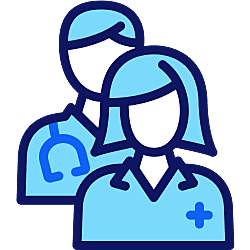What is a HIV rash?

Medically reviewed by
Dr Nicholas AntonakopoulosLast reviewed: 21 Mar 2022
What the HIV rashes looks like and how to treat them

Key takeaways
Rashes are common when you’ve got an HIV infection and they can have a number of causes
Rashes can be an early symptom of HIV infection, a result of your immune system being weaker, or a reaction to HIV medication
If you have an unknown rash and you think you could have been exposed to HIV you can tested
Get tested by ordering an online test kit or by going through a sexual health clinic or your GP
You may be able to manage outbreaks of your rash using some simple lifestyle changes or over-the-counter medications
HIV rash is a common symptom of HIV infection. Around 85% of HIV positive individuals will experience a rash at some point in their infection, due to either:
- Acute HIV infection
- A weakened immune system caused by chronic infection
- A bad reaction to anti-HIV medication
If you are worried that your rash might be due to an undiagnosed HIV infection, you can order an HIV testing kit from our team of online doctors and learn your status within 2 days.
from £29.99

No results found.
Please check your spelling or try another treatment name.
Acute HIV rash: a symptom of HIV infection
When people are first infected with HIV, they may experience an acute, 'flu-like' illness called a 'seroconversion illness,' about 2-4 weeks after being infected. The HIV rash is a symptom of this condition.
The rash will mostly affect the upper part of the body and will probably be found on the shoulders, chest area, face, torso and palms of the hands.
Typically the rash will be flat or barely raised with small reddish dots/spots in people with light skin, and dark purple/ black in people with dark skin.
The rash is not usually itchy and it tends to disappear within 3 weeks.
What to do if you notice an HIV rash
If you do notice this kind of rash and it's associated with any other acute symptoms of HIV, you should get HIV tested immediately.
You can order an HIV test kit online from one of our doctors, and find out your status within two days.
Over-the-counter medications like Hydrocortisone Cream can be used to help heal the rash and lessen itching, but you should always seek medical advice first.
HIV rash during ongoing infection
During ongoing HIV infection, as your immune system becomes damaged, you may experience red and itchy (pruritic) skin.
You may experience a number of skin conditions including:
- Psoriasis: Scaly lesions on elbows, hands and feet. Pre-existing psoriasis can also be exacerbated by new HIV infections.
- Seborrhoeic dermatitis: Occurs on the scalp, ears, eyebrows, chest axillae, groin and feet.
- Eosinophilic pustular folliculitis: Acne or pimples may appear around hair follicles on the upper arms and chest.
In addition to this, you may notice blisters in the 'moist' areas of the body such as the mouth, genitals and eyes.
Herpes and the HIV rash
Individuals with both HIV and herpes can often experience very severe HIV rashes, making related symptoms and outbreaks much worse.
Rashes may appear red and filled with fluid. They may periodically burst and crust over.
Treatment of these HIV rashes
Ongoing HIV rash can be managed with steroid creams and antihistamines, but these conditions will be difficult to eradicate completely and recurrence is common.
Most of these conditions will improve dramatically with effective antiretroviral treatment.
Phototherapy has proved effective at managing folliculitis in some patients.
Rashes due to HIV medication
HIV rashes often appear as either a side-effect of, or an allergic reaction to certain antiretroviral medication.
NNRTI medication: Causes the majority of skin rashes, with nevirapine rashes being the most severe. Women are at a particular risk of developing nevirapine rashes.
NRTI medication: Abacavir may cause severe allergic reaction rashes in some people. If you develop a rash while taking Ziagen, notify your doctor straight away.
PI medication: Amprenavir and tipranavir have both been known to cause rashes. Women taking contraceptive pills containing oestrogen are particularly at risk of developing a rash.
If you develop a rash, or any other new symptoms whilst on HIV medication, you should always seek medical advice straight away.
Steven-Johnson Syndrome (SJS) and Toxic Epidermal Necrolysis (TEN)
SJS and TEN are two serious (but rare) skin disorders that are caused by anti-HIV medication. These are both severe conditions that affect at least 30% of total body skin and must be treated by a doctor immediately.
Symptoms of SJS and TEN:
- Flat or raised red spots on the skin with central blisters.
- Blisters in the mouth, eyes and genitals.
- Peeling skin that results in painful sores.
- Fever, headache and general feelings of being unwell.
Coping with medication-induced HIV rashes
HIV rash can be itchy, irritating and unsightly. But there are ways of managing outbreaks:
- Avoid hot showers or baths.
- Use only mild toiletries and detergents.
- Wear cool fibres like cotton and stay away from wool.
- Invest in an air-humidifier.
- Use moisturisers/ emollients or calamine lotion.
If you're using anti-retroviral medication you should really avoid taking antihistamine tablets unless approved by your doctor as these can interfere with medication.

Dr Nicholas Antonakopoulos graduated from the University of London in 2006. He did his postgraduate training in hospitals in the London area, and he trained for four years in Trauma and Orthopaedic Surgery before completing his training in General practice in 2015.
Meet our doctorsLast reviewed: 21 Mar 2022
-
HIV & AIDS, National Health Service [accessed February 2023]
-
HIV and AIDS, Symptoms, National Health Service [accessed February 2023]
-
Fever and rash in patients with HIV, UpToDate [accessed February 2023]
-
Stevens-Johnson syndrome, National Health Service [accessed February 2023]
-
Toxic Epidermal Necrolysis, StatPearls [accessed February 2023]
ZAVA offers a convenient and discreet service to test for sexually transmitted infections. You will receive your test kit by post. Follow the instructions provided with the test kit and collect a sample (depending on the test kit this could be a blood, saliva, urine sample or genital swab). The test kit comes with an envelope, ready to send to our partner laboratory which will analyse your sample. Once your result has come back, you will be able to view it in your secure ZAVA account. We will never send medical or personal information via email.









